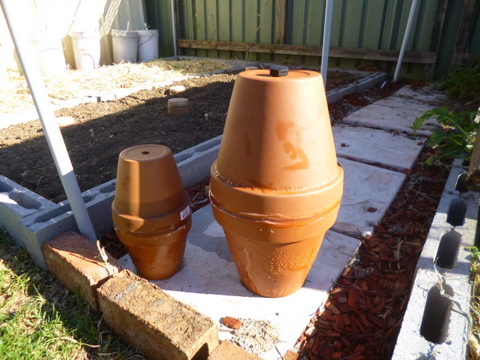Mulch is a material that may be organic (compost, hay, straw) or inorganic (rocks, gravel) that is applied to cover bare soil. It has a number of advantages over leaving the soil bare –
- It reduces evaporation, keeping the soil moister and reducing the need for watering.
- It insulates the soil against extremes of temperature.
- If it is organic, it will break down and provide nutrients for plants
- It can help support bacterial or fungal soil biota (more on this later).
- Weed growth and the germination of weed seeds is suppressed
- Rain drops hitting bare soil can result in the soil surface being compressed causing the rain to then run off. Mulch absorbs the energy of the falling raindrops allowing water to infiltrate the soil rather than be lost.
- Soil erosion is reduced, due to reduced rain runoff.
So you can see that there are lots of good reasons to use mulch when you are growing your fruit and veg, herbs, flowers etc. For these reasons I integrated mulch into our growing regime very early on. We use two main types of mulch, straw and wood chips with the occasional application of other stuff.
Straw Mulch
Straw is an organic mulch that supports bacterial soil biota which favours the production from our annual vegetable beds. Over the years that we have been growing, depending on availability, we use straw, but we have also used Lucerne hay when we wanted to add a nitrogen boost to the soil. Also, for a couple of years, there was a local producer of grass hay which we used extensively for as long as we could but they went out of business years ago. We now buy wheaten straw from a local produce merchant only a couple of kilometres away.
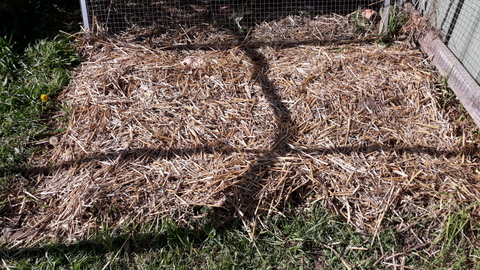
Bed mulched and ready to plant out
Wheat straw is great stuff for mulch but one downside is that it will contain variable amounts of wheat seeds. This is great if you want to grow a bit of wheat in your mulch, but not so much fun if you don’t. We have strategy for this, before going onto the veggie patch, each bale of wheat straw goes through the ‘Retirement Village’.
The retirement village is a shed where we keep our chooks that are a bit old for the chook tractor and not as productive and as I need I toss in a bale of straw for them to sort through. This has a number of advantages –
- They remove and eat the wheat seeds,
- They break the straw down a bit so it is easier to handle, and
- The add manure to it, increasing the fertility added to the soil and adding nitrogen to the high carbon straw to facilitate it breaking down.
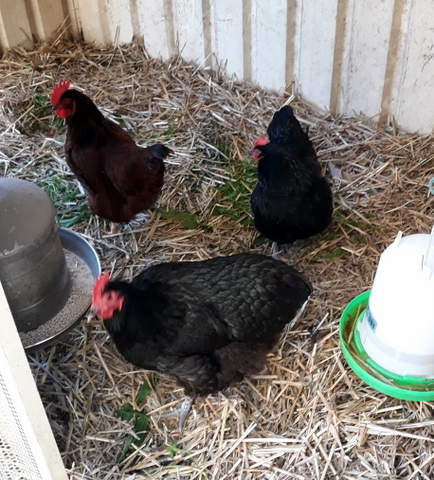
The retirement village, where chooks root out and eat wheat grains and tell eachother stories of what it was like "back in their day"
Once the chook tractor has dug over and manured a patch, the straw from the retirement village is applied roughly at the rate of one wheelbarrow full per metre squared. In most cases this is enough, but occasionally we might get a bit of a problem weed infestation (like oxalis) and I will get hold of some newspapers, soak them, then apply them in pack of 10 to 20 sheets, overlapping over the full bed, before applying the broken down straw.
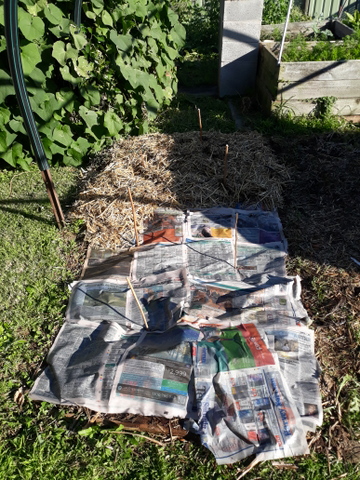
Bed with soaked newspaper applied and partially coered with straw
The mulch usually holds up for the six months that the bed is producing then the chook tractor comes back round and the chooks then dig in any remaining straw into the bed, and the process starts again.
This cycle has been ongoing for over 15 years and we find it works very well.
Wood Chips
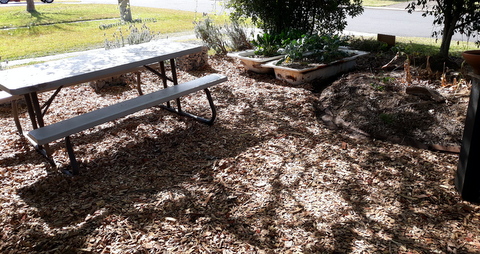
Under the mulberry tree, freshly applied wood chips
Wood chips support a fungal soil biota which allows trees, shrubs and other perennials to do well. For the most part we buy it in every few years as it is needed, and put it under the mulberry tree, around the fruit tree circle, along the front of the property on the LUFFA, and various other perennial beds.
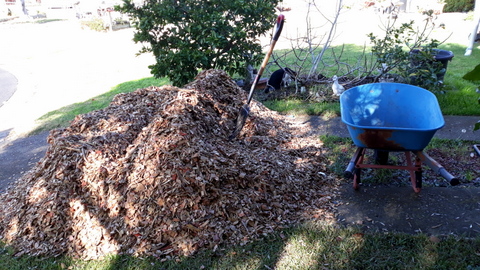
Pile of woodchip ready to be applied
A while ago, while driving around I noticed a pile of wood chips on some vacant land near a roundabout. It appeared to me that an arborist was using it as a dumping ground for tree shreddings rather than taking them to the tip, thus saving a bit of money. This worked pretty well for me as it was not far from home and I could go over, fill the back of the car up and then come home and spread it. Unfortunately someone (I suspect the land owner) put a stop to it by cleaning the land up and then installing a fence. So we are back to buying it again.
If you have a decent amount of land, you can approach local arborists and let them know you would like to receive a load of shreddings they will often deliver them for free. The will, however deliver what they have in the truck and it will be all or nothing, and the ‘all’ may be 25 to 30 tonnes. This doesn’t work for us because we just don’t have the room but may work for someone with land to spare, and/or lots of friends who could share in your bounty. Otherwise, keep an eye out on vacant land in your area for some piles of unwanted wood chips!
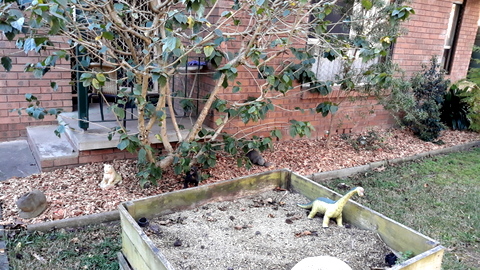
Front garden, re-mulched
Other Stuff
We do make some use of organic material that is produced on our place –
Corn Stalks – If we get a good season for corn, I will pull up the stalks and run them through our old electric shredder. Like me, it has some quirks and can be a pain at times, but eventually I got it to shred up the cornstalks from two patches, effectively providing free mulch for about half of one of the three metre beds.
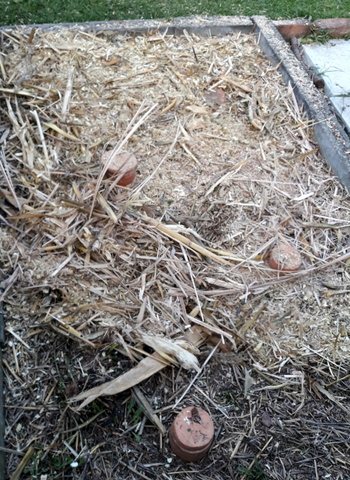
Cornstalk mulch
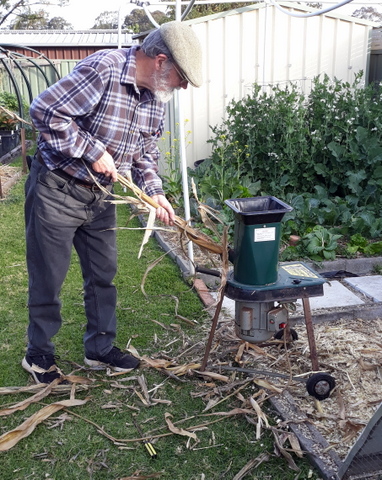
Some old bugger shredding cornstalks in my back yard!
Banana leaves and papyrus – The Jerusalem artichoke bed gets a mulch that is a combination of dried out banana leaves and papyrus from the water garden. The banana circle in the back yard is prolific in shedding banana leaves all over the place so we gather these up and put them of the Jerusalem artichokes, and at the same time, we gather papyrus stalks that have dried off and place them over the top of the Jerusalem artichokes as well, forming a mulch that is light but which also has good coverage.
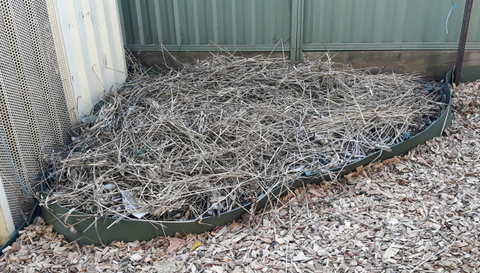
Irrigation
We do get some extreme weather out here and it can get very hot and dry in summer, we have found that applying mulch where we can keeps the soil and the plants happier, and means we don’t have to irrigate as much. We have systems that allow us to irrigate through the mulch directly into the soil underneath, ollas for the veggie beds and deep pipe waterers for the perennials. This allows us make the best use of water in dry times.
Ollas

Deep Pipe Waterer
Downside
We have found lots of up-sides to mulch and not so much downsides, but one that we have found is that lots of rain, particularly in the colder parts of the year, can result in soil waterlogging. Plants like citrus trees that do not cope well with wet feet can be damaged. If this happens, we scrape the mulch away from the base of the plant until things dry out.



